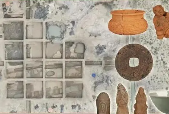Ancient Coin Collection and Photogrammetry in Zhangjiakou, China
In the ancient city of Zhangjiakou, a remarkable discovery has been made: a collection of ancient coins dating back to the Han Dynasty (202 BC – 220 AD). The site was unearthed by a team of archaeologists using cutting-edge photogrammetry techniques. These coins offer a glimpse into the rich economic history of the region and shed light on the complex trade networks that existed during that period.
The excavation site is situated near the city’s northern outskirts, where the terrain has preserved the coins remarkably well over centuries. The team, led by Professor Li from the Northeastern University, employed advanced photogrammetry technology to map the entire area, revealing not only the coins but also potential artifacts hidden underground. "This technology allows us to capture detailed 3D models of the excavation site," said Prof. Li. "It’s like peering into the past with modern eyes."

The ancient coins discovered range in size and design, with some featuring intricate carvings depicting mythological creatures and deities. One of the most notable findings includes a series of rare silver coins with inscriptions that provide evidence of trade with distant regions during the dynasty era. This indicates the city of Zhangjiakou was once a bustling center for trade and commerce, connecting the northern border regions with southern China.
The ongoing study aims to understand the broader context of these coins and their significance in the wider landscape of Chinese history. Further research could reveal even more about the social and economic structures of ancient China. Stay tuned for updates as this exciting project unfolds!
 LongStory.Asia The Digital Archaeological Portal
LongStory.Asia The Digital Archaeological Portal